Marketing Principles & Practices: SOSTAC Analysis of Whole Food Market
VerifiedAdded on 2023/06/17
|12
|3451
|199
Report
AI Summary
This report provides a comprehensive analysis of Whole Food Market's marketing principles and practices, focusing on its potential expansion into India. It employs the SOSTAC framework, beginning with a situational analysis using PESTEL to assess the macro-environmental factors, including political, economic, social, technological, environmental, and legal aspects that could impact Whole Food's operations in India. The report then delves into the marketing mix (4Ps), examining the product offerings, pricing strategies, distribution channels, and promotional activities relevant to the Indian market. Specifically, it discusses Whole Food's premium pricing strategy, product lines, and the importance of adapting to cultural diversity and technological advancements. Furthermore, the report outlines the action and control elements of the SOSTAC model, emphasizing the importance of waste disposal, sustainability, and staff training to ensure quality and customer satisfaction. The analysis concludes by highlighting the objectives of Whole Food Market in expanding its business globally and generating more revenue.
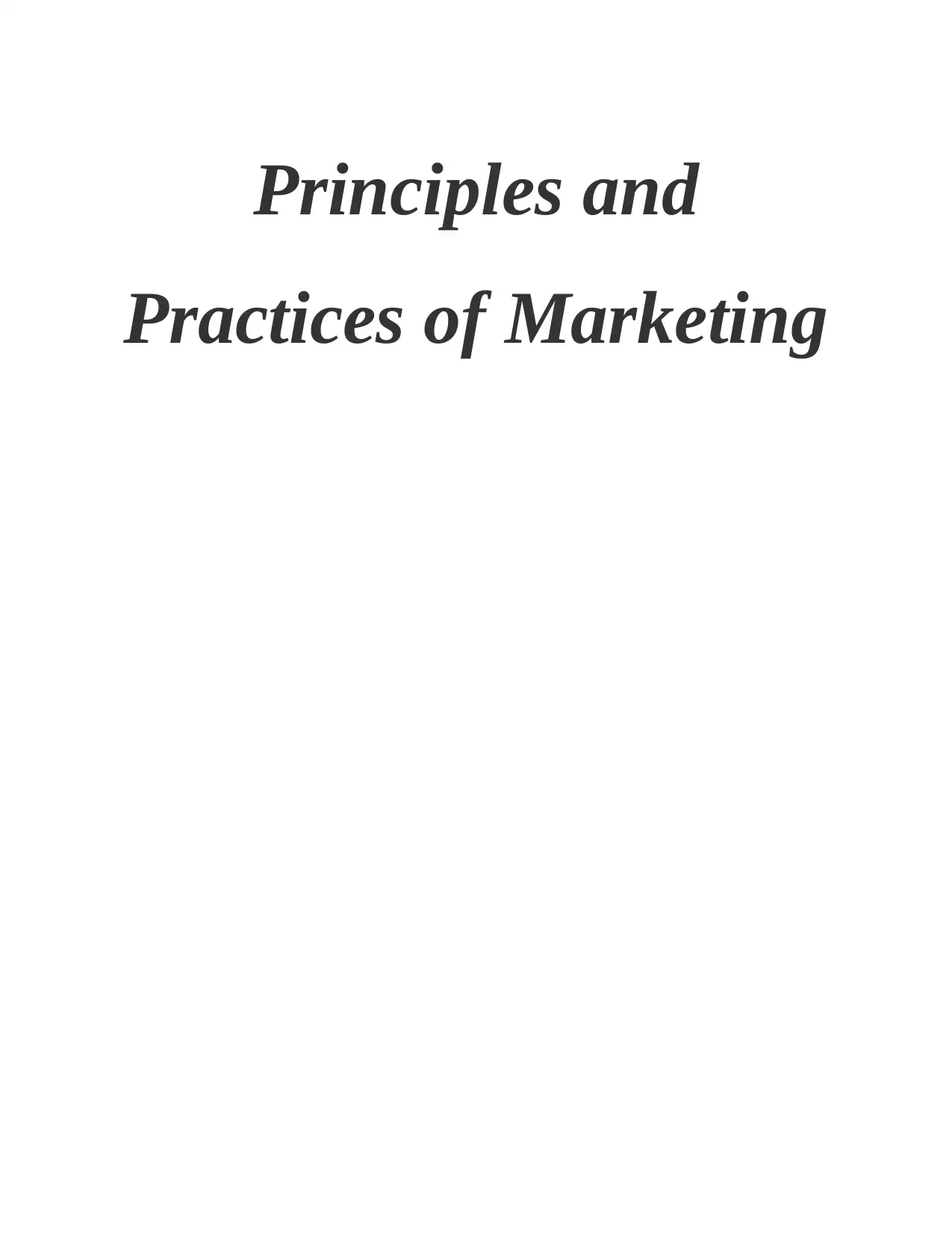
Principles and
Practices of Marketing
Practices of Marketing
Paraphrase This Document
Need a fresh take? Get an instant paraphrase of this document with our AI Paraphraser
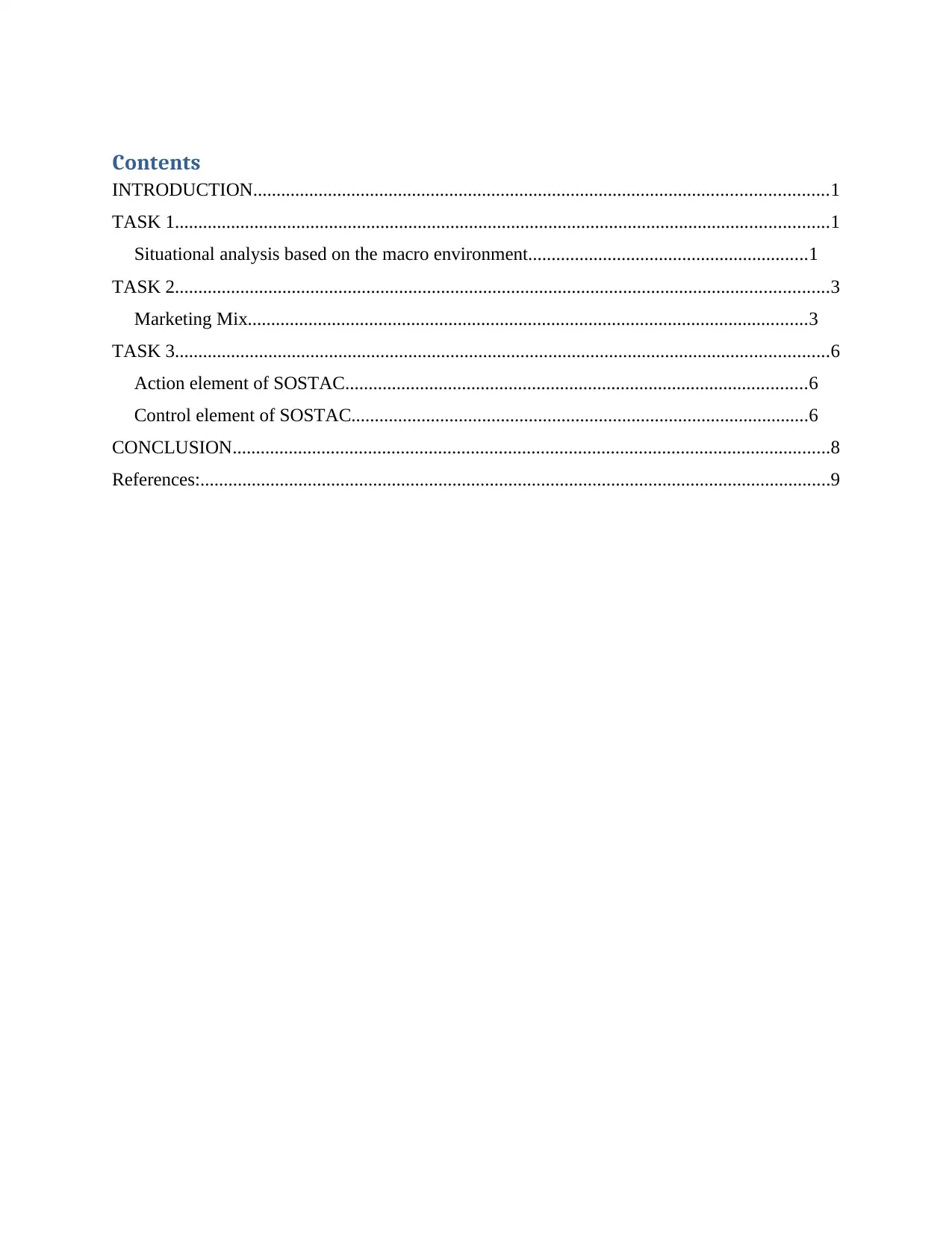
Contents
INTRODUCTION...........................................................................................................................1
TASK 1............................................................................................................................................1
Situational analysis based on the macro environment............................................................1
TASK 2............................................................................................................................................3
Marketing Mix........................................................................................................................3
TASK 3............................................................................................................................................6
Action element of SOSTAC...................................................................................................6
Control element of SOSTAC..................................................................................................6
CONCLUSION................................................................................................................................8
References:.......................................................................................................................................9
INTRODUCTION...........................................................................................................................1
TASK 1............................................................................................................................................1
Situational analysis based on the macro environment............................................................1
TASK 2............................................................................................................................................3
Marketing Mix........................................................................................................................3
TASK 3............................................................................................................................................6
Action element of SOSTAC...................................................................................................6
Control element of SOSTAC..................................................................................................6
CONCLUSION................................................................................................................................8
References:.......................................................................................................................................9

⊘ This is a preview!⊘
Do you want full access?
Subscribe today to unlock all pages.

Trusted by 1+ million students worldwide
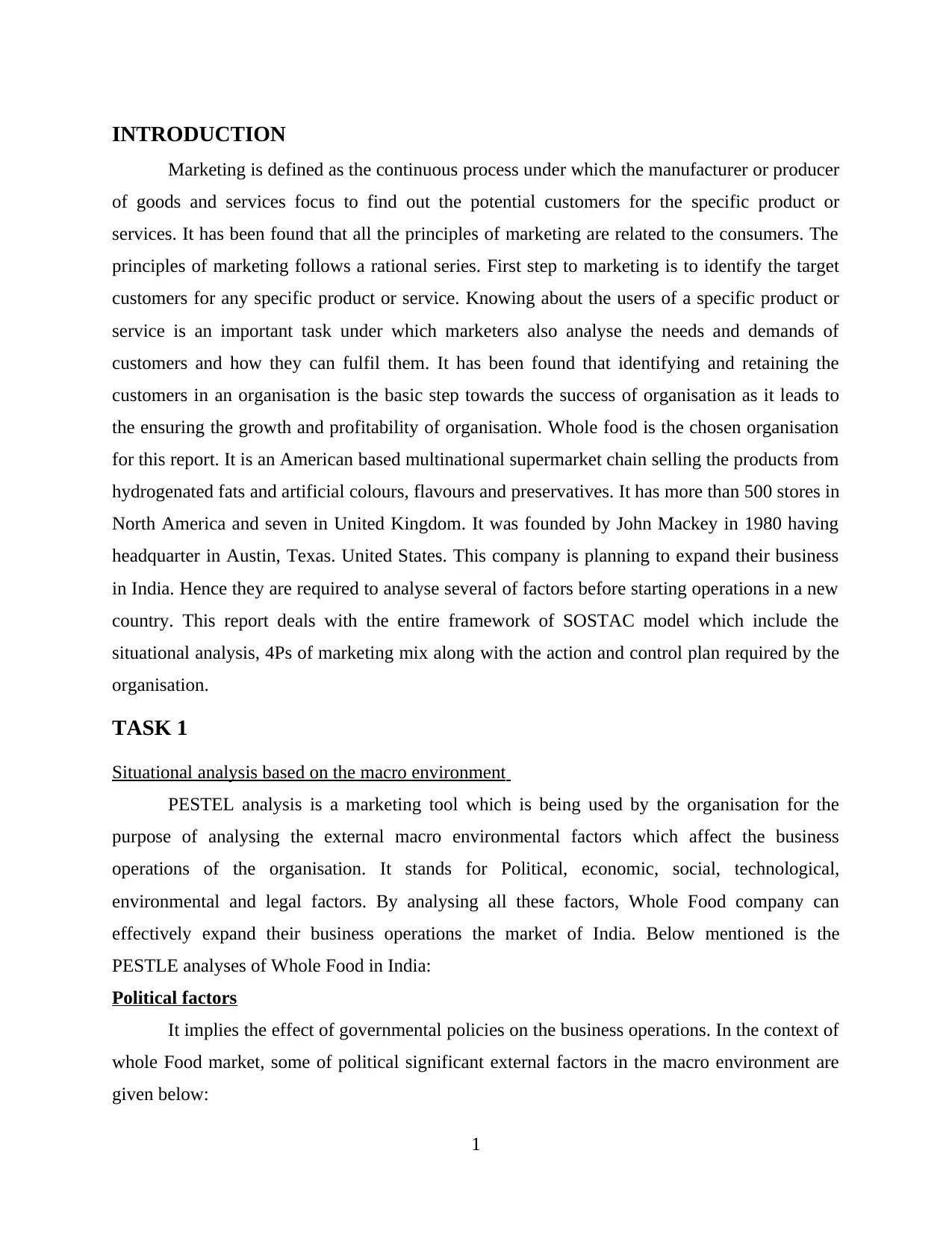
INTRODUCTION
Marketing is defined as the continuous process under which the manufacturer or producer
of goods and services focus to find out the potential customers for the specific product or
services. It has been found that all the principles of marketing are related to the consumers. The
principles of marketing follows a rational series. First step to marketing is to identify the target
customers for any specific product or service. Knowing about the users of a specific product or
service is an important task under which marketers also analyse the needs and demands of
customers and how they can fulfil them. It has been found that identifying and retaining the
customers in an organisation is the basic step towards the success of organisation as it leads to
the ensuring the growth and profitability of organisation. Whole food is the chosen organisation
for this report. It is an American based multinational supermarket chain selling the products from
hydrogenated fats and artificial colours, flavours and preservatives. It has more than 500 stores in
North America and seven in United Kingdom. It was founded by John Mackey in 1980 having
headquarter in Austin, Texas. United States. This company is planning to expand their business
in India. Hence they are required to analyse several of factors before starting operations in a new
country. This report deals with the entire framework of SOSTAC model which include the
situational analysis, 4Ps of marketing mix along with the action and control plan required by the
organisation.
TASK 1
Situational analysis based on the macro environment
PESTEL analysis is a marketing tool which is being used by the organisation for the
purpose of analysing the external macro environmental factors which affect the business
operations of the organisation. It stands for Political, economic, social, technological,
environmental and legal factors. By analysing all these factors, Whole Food company can
effectively expand their business operations the market of India. Below mentioned is the
PESTLE analyses of Whole Food in India:
Political factors
It implies the effect of governmental policies on the business operations. In the context of
whole Food market, some of political significant external factors in the macro environment are
given below:
1
Marketing is defined as the continuous process under which the manufacturer or producer
of goods and services focus to find out the potential customers for the specific product or
services. It has been found that all the principles of marketing are related to the consumers. The
principles of marketing follows a rational series. First step to marketing is to identify the target
customers for any specific product or service. Knowing about the users of a specific product or
service is an important task under which marketers also analyse the needs and demands of
customers and how they can fulfil them. It has been found that identifying and retaining the
customers in an organisation is the basic step towards the success of organisation as it leads to
the ensuring the growth and profitability of organisation. Whole food is the chosen organisation
for this report. It is an American based multinational supermarket chain selling the products from
hydrogenated fats and artificial colours, flavours and preservatives. It has more than 500 stores in
North America and seven in United Kingdom. It was founded by John Mackey in 1980 having
headquarter in Austin, Texas. United States. This company is planning to expand their business
in India. Hence they are required to analyse several of factors before starting operations in a new
country. This report deals with the entire framework of SOSTAC model which include the
situational analysis, 4Ps of marketing mix along with the action and control plan required by the
organisation.
TASK 1
Situational analysis based on the macro environment
PESTEL analysis is a marketing tool which is being used by the organisation for the
purpose of analysing the external macro environmental factors which affect the business
operations of the organisation. It stands for Political, economic, social, technological,
environmental and legal factors. By analysing all these factors, Whole Food company can
effectively expand their business operations the market of India. Below mentioned is the
PESTLE analyses of Whole Food in India:
Political factors
It implies the effect of governmental policies on the business operations. In the context of
whole Food market, some of political significant external factors in the macro environment are
given below:
1
Paraphrase This Document
Need a fresh take? Get an instant paraphrase of this document with our AI Paraphraser
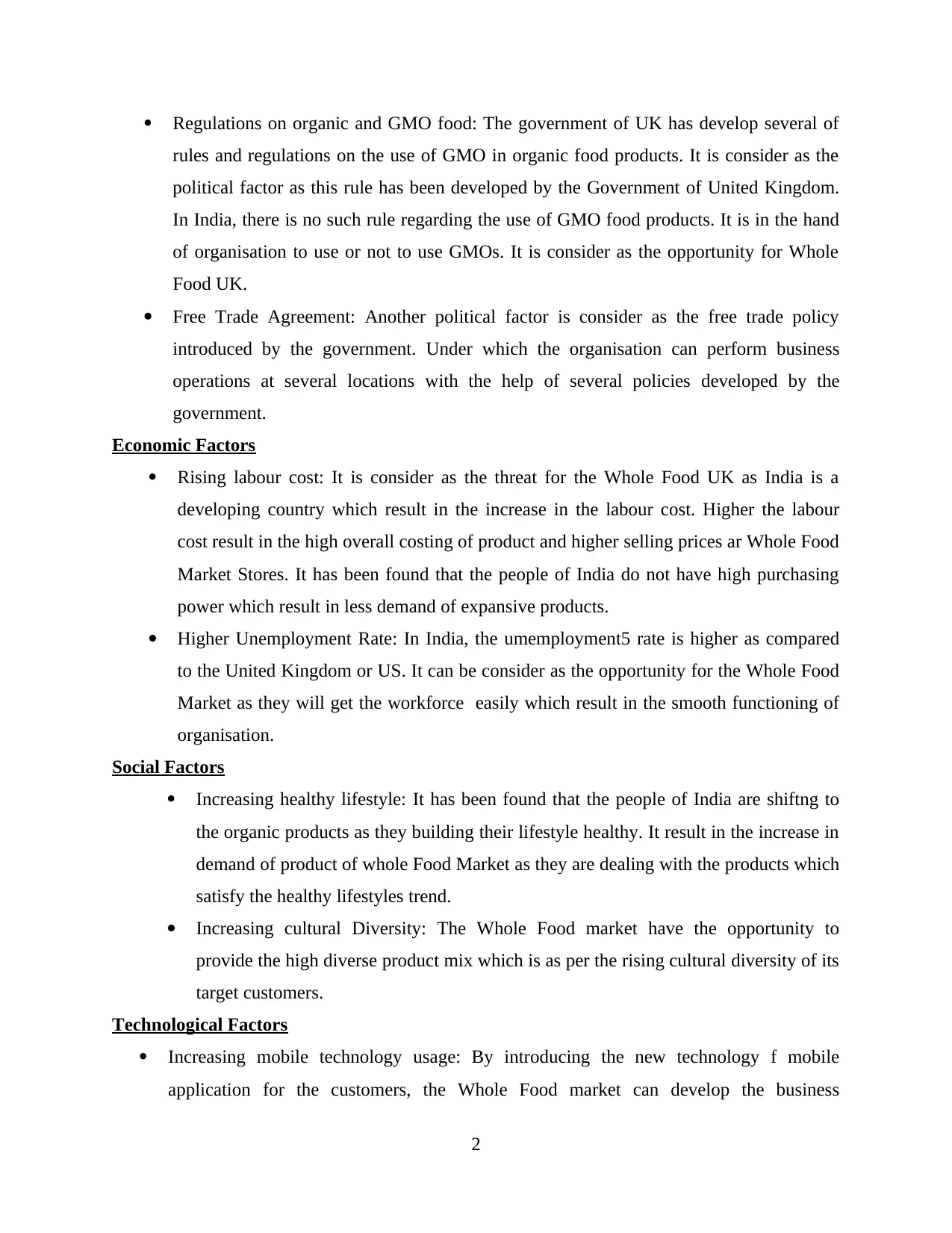
Regulations on organic and GMO food: The government of UK has develop several of
rules and regulations on the use of GMO in organic food products. It is consider as the
political factor as this rule has been developed by the Government of United Kingdom.
In India, there is no such rule regarding the use of GMO food products. It is in the hand
of organisation to use or not to use GMOs. It is consider as the opportunity for Whole
Food UK.
Free Trade Agreement: Another political factor is consider as the free trade policy
introduced by the government. Under which the organisation can perform business
operations at several locations with the help of several policies developed by the
government.
Economic Factors
Rising labour cost: It is consider as the threat for the Whole Food UK as India is a
developing country which result in the increase in the labour cost. Higher the labour
cost result in the high overall costing of product and higher selling prices ar Whole Food
Market Stores. It has been found that the people of India do not have high purchasing
power which result in less demand of expansive products.
Higher Unemployment Rate: In India, the umemployment5 rate is higher as compared
to the United Kingdom or US. It can be consider as the opportunity for the Whole Food
Market as they will get the workforce easily which result in the smooth functioning of
organisation.
Social Factors
Increasing healthy lifestyle: It has been found that the people of India are shiftng to
the organic products as they building their lifestyle healthy. It result in the increase in
demand of product of whole Food Market as they are dealing with the products which
satisfy the healthy lifestyles trend.
Increasing cultural Diversity: The Whole Food market have the opportunity to
provide the high diverse product mix which is as per the rising cultural diversity of its
target customers.
Technological Factors
Increasing mobile technology usage: By introducing the new technology f mobile
application for the customers, the Whole Food market can develop the business
2
rules and regulations on the use of GMO in organic food products. It is consider as the
political factor as this rule has been developed by the Government of United Kingdom.
In India, there is no such rule regarding the use of GMO food products. It is in the hand
of organisation to use or not to use GMOs. It is consider as the opportunity for Whole
Food UK.
Free Trade Agreement: Another political factor is consider as the free trade policy
introduced by the government. Under which the organisation can perform business
operations at several locations with the help of several policies developed by the
government.
Economic Factors
Rising labour cost: It is consider as the threat for the Whole Food UK as India is a
developing country which result in the increase in the labour cost. Higher the labour
cost result in the high overall costing of product and higher selling prices ar Whole Food
Market Stores. It has been found that the people of India do not have high purchasing
power which result in less demand of expansive products.
Higher Unemployment Rate: In India, the umemployment5 rate is higher as compared
to the United Kingdom or US. It can be consider as the opportunity for the Whole Food
Market as they will get the workforce easily which result in the smooth functioning of
organisation.
Social Factors
Increasing healthy lifestyle: It has been found that the people of India are shiftng to
the organic products as they building their lifestyle healthy. It result in the increase in
demand of product of whole Food Market as they are dealing with the products which
satisfy the healthy lifestyles trend.
Increasing cultural Diversity: The Whole Food market have the opportunity to
provide the high diverse product mix which is as per the rising cultural diversity of its
target customers.
Technological Factors
Increasing mobile technology usage: By introducing the new technology f mobile
application for the customers, the Whole Food market can develop the business
2
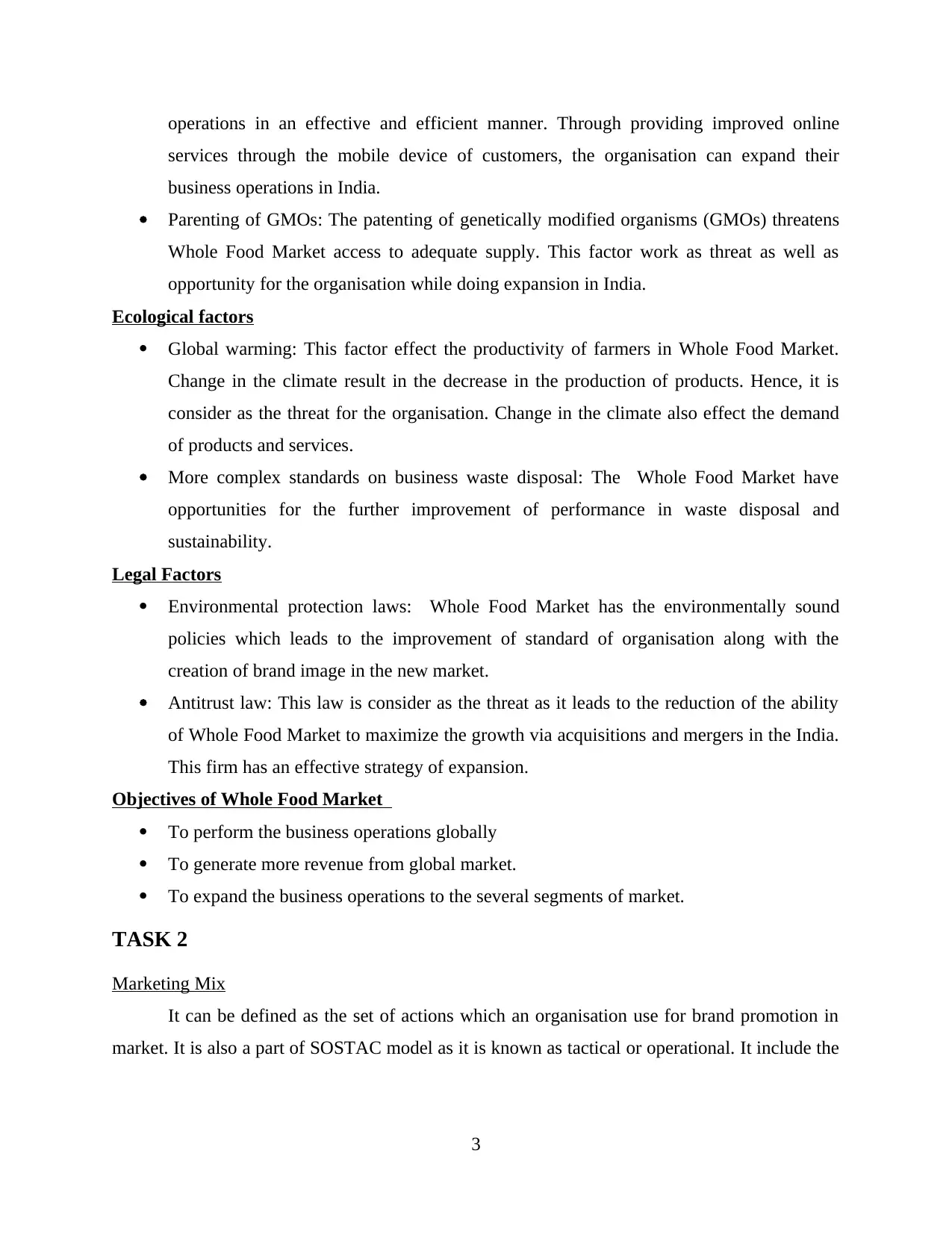
operations in an effective and efficient manner. Through providing improved online
services through the mobile device of customers, the organisation can expand their
business operations in India.
Parenting of GMOs: The patenting of genetically modified organisms (GMOs) threatens
Whole Food Market access to adequate supply. This factor work as threat as well as
opportunity for the organisation while doing expansion in India.
Ecological factors
Global warming: This factor effect the productivity of farmers in Whole Food Market.
Change in the climate result in the decrease in the production of products. Hence, it is
consider as the threat for the organisation. Change in the climate also effect the demand
of products and services.
More complex standards on business waste disposal: The Whole Food Market have
opportunities for the further improvement of performance in waste disposal and
sustainability.
Legal Factors
Environmental protection laws: Whole Food Market has the environmentally sound
policies which leads to the improvement of standard of organisation along with the
creation of brand image in the new market.
Antitrust law: This law is consider as the threat as it leads to the reduction of the ability
of Whole Food Market to maximize the growth via acquisitions and mergers in the India.
This firm has an effective strategy of expansion.
Objectives of Whole Food Market
To perform the business operations globally
To generate more revenue from global market.
To expand the business operations to the several segments of market.
TASK 2
Marketing Mix
It can be defined as the set of actions which an organisation use for brand promotion in
market. It is also a part of SOSTAC model as it is known as tactical or operational. It include the
3
services through the mobile device of customers, the organisation can expand their
business operations in India.
Parenting of GMOs: The patenting of genetically modified organisms (GMOs) threatens
Whole Food Market access to adequate supply. This factor work as threat as well as
opportunity for the organisation while doing expansion in India.
Ecological factors
Global warming: This factor effect the productivity of farmers in Whole Food Market.
Change in the climate result in the decrease in the production of products. Hence, it is
consider as the threat for the organisation. Change in the climate also effect the demand
of products and services.
More complex standards on business waste disposal: The Whole Food Market have
opportunities for the further improvement of performance in waste disposal and
sustainability.
Legal Factors
Environmental protection laws: Whole Food Market has the environmentally sound
policies which leads to the improvement of standard of organisation along with the
creation of brand image in the new market.
Antitrust law: This law is consider as the threat as it leads to the reduction of the ability
of Whole Food Market to maximize the growth via acquisitions and mergers in the India.
This firm has an effective strategy of expansion.
Objectives of Whole Food Market
To perform the business operations globally
To generate more revenue from global market.
To expand the business operations to the several segments of market.
TASK 2
Marketing Mix
It can be defined as the set of actions which an organisation use for brand promotion in
market. It is also a part of SOSTAC model as it is known as tactical or operational. It include the
3
⊘ This is a preview!⊘
Do you want full access?
Subscribe today to unlock all pages.

Trusted by 1+ million students worldwide
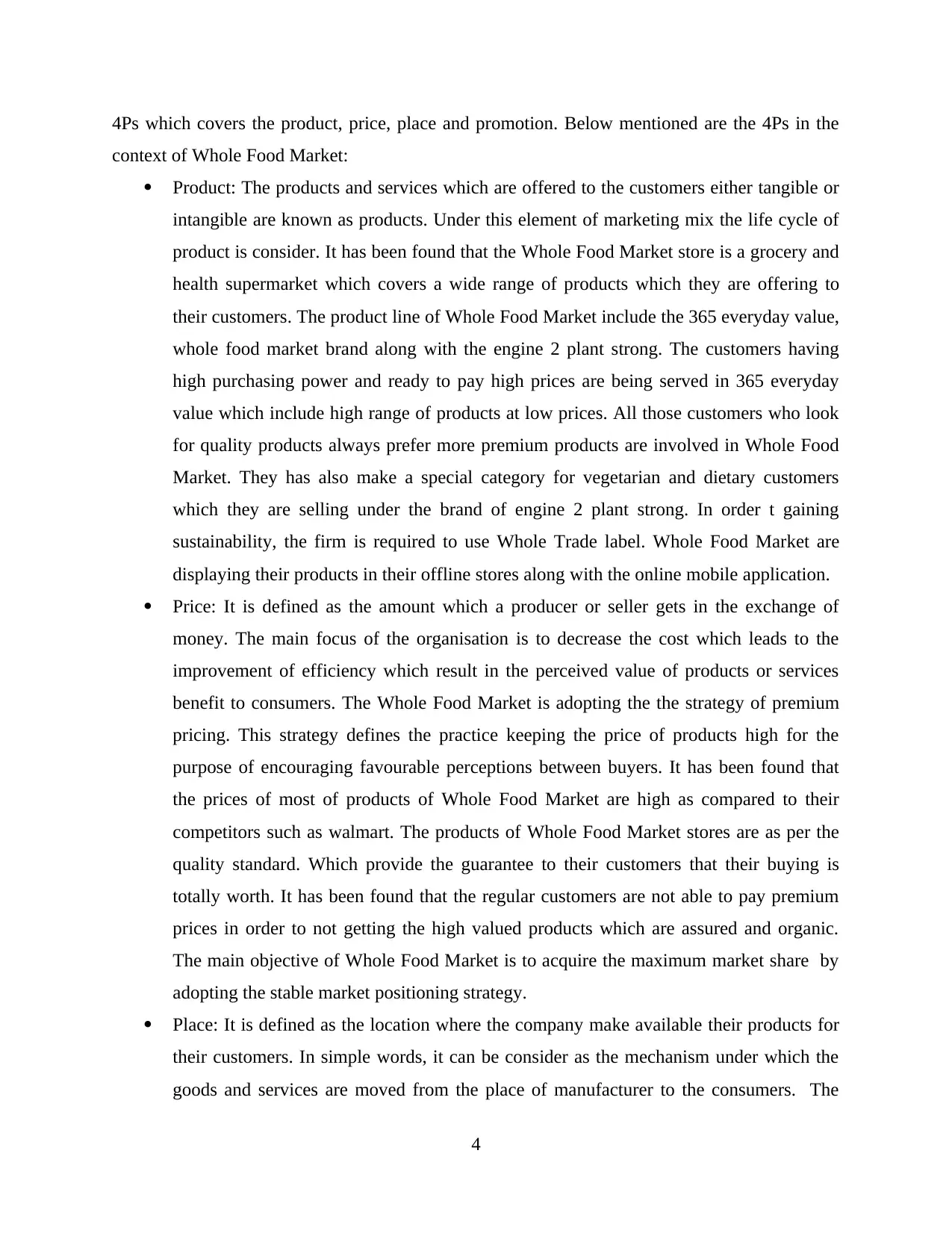
4Ps which covers the product, price, place and promotion. Below mentioned are the 4Ps in the
context of Whole Food Market:
Product: The products and services which are offered to the customers either tangible or
intangible are known as products. Under this element of marketing mix the life cycle of
product is consider. It has been found that the Whole Food Market store is a grocery and
health supermarket which covers a wide range of products which they are offering to
their customers. The product line of Whole Food Market include the 365 everyday value,
whole food market brand along with the engine 2 plant strong. The customers having
high purchasing power and ready to pay high prices are being served in 365 everyday
value which include high range of products at low prices. All those customers who look
for quality products always prefer more premium products are involved in Whole Food
Market. They has also make a special category for vegetarian and dietary customers
which they are selling under the brand of engine 2 plant strong. In order t gaining
sustainability, the firm is required to use Whole Trade label. Whole Food Market are
displaying their products in their offline stores along with the online mobile application.
Price: It is defined as the amount which a producer or seller gets in the exchange of
money. The main focus of the organisation is to decrease the cost which leads to the
improvement of efficiency which result in the perceived value of products or services
benefit to consumers. The Whole Food Market is adopting the the strategy of premium
pricing. This strategy defines the practice keeping the price of products high for the
purpose of encouraging favourable perceptions between buyers. It has been found that
the prices of most of products of Whole Food Market are high as compared to their
competitors such as walmart. The products of Whole Food Market stores are as per the
quality standard. Which provide the guarantee to their customers that their buying is
totally worth. It has been found that the regular customers are not able to pay premium
prices in order to not getting the high valued products which are assured and organic.
The main objective of Whole Food Market is to acquire the maximum market share by
adopting the stable market positioning strategy.
Place: It is defined as the location where the company make available their products for
their customers. In simple words, it can be consider as the mechanism under which the
goods and services are moved from the place of manufacturer to the consumers. The
4
context of Whole Food Market:
Product: The products and services which are offered to the customers either tangible or
intangible are known as products. Under this element of marketing mix the life cycle of
product is consider. It has been found that the Whole Food Market store is a grocery and
health supermarket which covers a wide range of products which they are offering to
their customers. The product line of Whole Food Market include the 365 everyday value,
whole food market brand along with the engine 2 plant strong. The customers having
high purchasing power and ready to pay high prices are being served in 365 everyday
value which include high range of products at low prices. All those customers who look
for quality products always prefer more premium products are involved in Whole Food
Market. They has also make a special category for vegetarian and dietary customers
which they are selling under the brand of engine 2 plant strong. In order t gaining
sustainability, the firm is required to use Whole Trade label. Whole Food Market are
displaying their products in their offline stores along with the online mobile application.
Price: It is defined as the amount which a producer or seller gets in the exchange of
money. The main focus of the organisation is to decrease the cost which leads to the
improvement of efficiency which result in the perceived value of products or services
benefit to consumers. The Whole Food Market is adopting the the strategy of premium
pricing. This strategy defines the practice keeping the price of products high for the
purpose of encouraging favourable perceptions between buyers. It has been found that
the prices of most of products of Whole Food Market are high as compared to their
competitors such as walmart. The products of Whole Food Market stores are as per the
quality standard. Which provide the guarantee to their customers that their buying is
totally worth. It has been found that the regular customers are not able to pay premium
prices in order to not getting the high valued products which are assured and organic.
The main objective of Whole Food Market is to acquire the maximum market share by
adopting the stable market positioning strategy.
Place: It is defined as the location where the company make available their products for
their customers. In simple words, it can be consider as the mechanism under which the
goods and services are moved from the place of manufacturer to the consumers. The
4
Paraphrase This Document
Need a fresh take? Get an instant paraphrase of this document with our AI Paraphraser
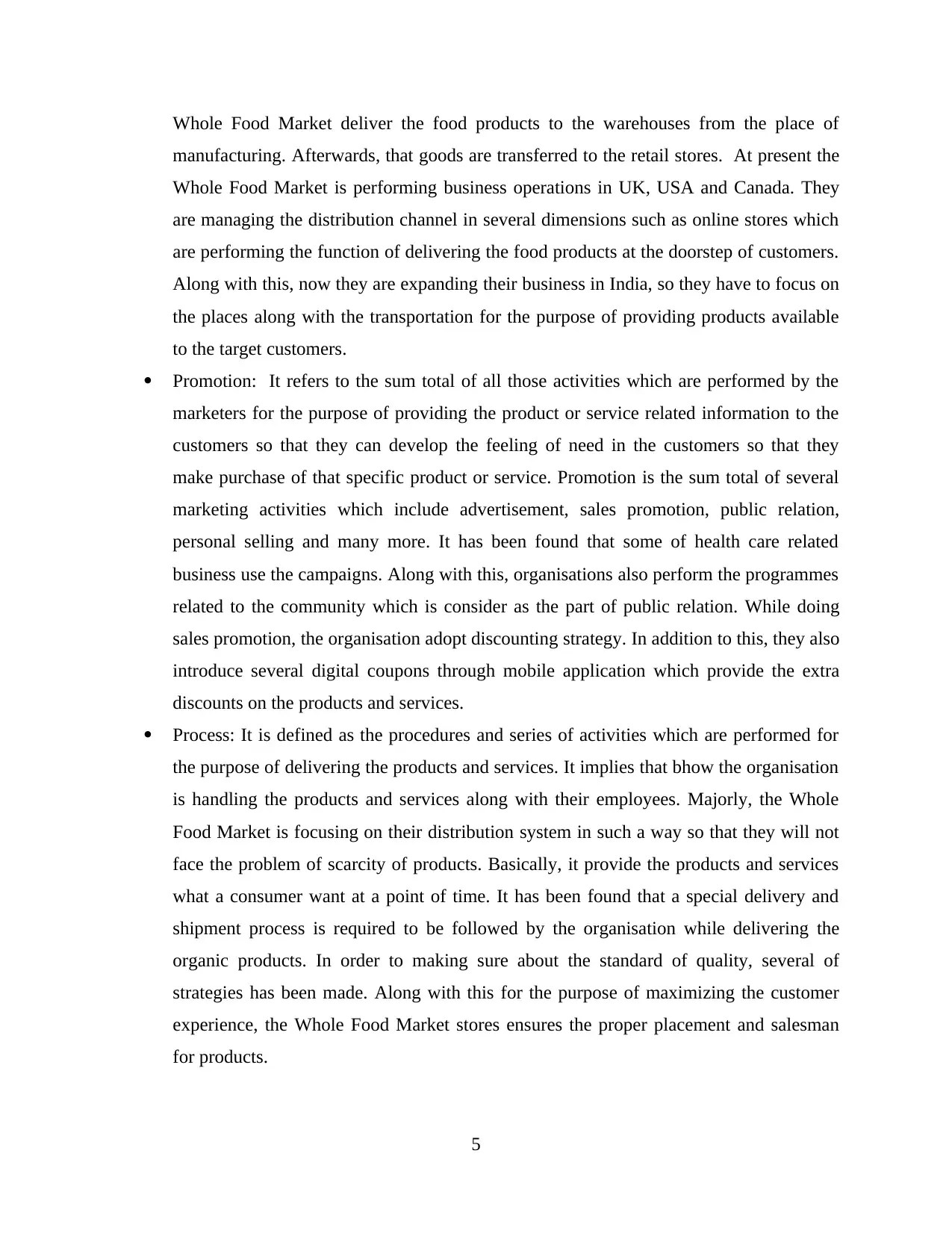
Whole Food Market deliver the food products to the warehouses from the place of
manufacturing. Afterwards, that goods are transferred to the retail stores. At present the
Whole Food Market is performing business operations in UK, USA and Canada. They
are managing the distribution channel in several dimensions such as online stores which
are performing the function of delivering the food products at the doorstep of customers.
Along with this, now they are expanding their business in India, so they have to focus on
the places along with the transportation for the purpose of providing products available
to the target customers.
Promotion: It refers to the sum total of all those activities which are performed by the
marketers for the purpose of providing the product or service related information to the
customers so that they can develop the feeling of need in the customers so that they
make purchase of that specific product or service. Promotion is the sum total of several
marketing activities which include advertisement, sales promotion, public relation,
personal selling and many more. It has been found that some of health care related
business use the campaigns. Along with this, organisations also perform the programmes
related to the community which is consider as the part of public relation. While doing
sales promotion, the organisation adopt discounting strategy. In addition to this, they also
introduce several digital coupons through mobile application which provide the extra
discounts on the products and services.
Process: It is defined as the procedures and series of activities which are performed for
the purpose of delivering the products and services. It implies that bhow the organisation
is handling the products and services along with their employees. Majorly, the Whole
Food Market is focusing on their distribution system in such a way so that they will not
face the problem of scarcity of products. Basically, it provide the products and services
what a consumer want at a point of time. It has been found that a special delivery and
shipment process is required to be followed by the organisation while delivering the
organic products. In order to making sure about the standard of quality, several of
strategies has been made. Along with this for the purpose of maximizing the customer
experience, the Whole Food Market stores ensures the proper placement and salesman
for products.
5
manufacturing. Afterwards, that goods are transferred to the retail stores. At present the
Whole Food Market is performing business operations in UK, USA and Canada. They
are managing the distribution channel in several dimensions such as online stores which
are performing the function of delivering the food products at the doorstep of customers.
Along with this, now they are expanding their business in India, so they have to focus on
the places along with the transportation for the purpose of providing products available
to the target customers.
Promotion: It refers to the sum total of all those activities which are performed by the
marketers for the purpose of providing the product or service related information to the
customers so that they can develop the feeling of need in the customers so that they
make purchase of that specific product or service. Promotion is the sum total of several
marketing activities which include advertisement, sales promotion, public relation,
personal selling and many more. It has been found that some of health care related
business use the campaigns. Along with this, organisations also perform the programmes
related to the community which is consider as the part of public relation. While doing
sales promotion, the organisation adopt discounting strategy. In addition to this, they also
introduce several digital coupons through mobile application which provide the extra
discounts on the products and services.
Process: It is defined as the procedures and series of activities which are performed for
the purpose of delivering the products and services. It implies that bhow the organisation
is handling the products and services along with their employees. Majorly, the Whole
Food Market is focusing on their distribution system in such a way so that they will not
face the problem of scarcity of products. Basically, it provide the products and services
what a consumer want at a point of time. It has been found that a special delivery and
shipment process is required to be followed by the organisation while delivering the
organic products. In order to making sure about the standard of quality, several of
strategies has been made. Along with this for the purpose of maximizing the customer
experience, the Whole Food Market stores ensures the proper placement and salesman
for products.
5
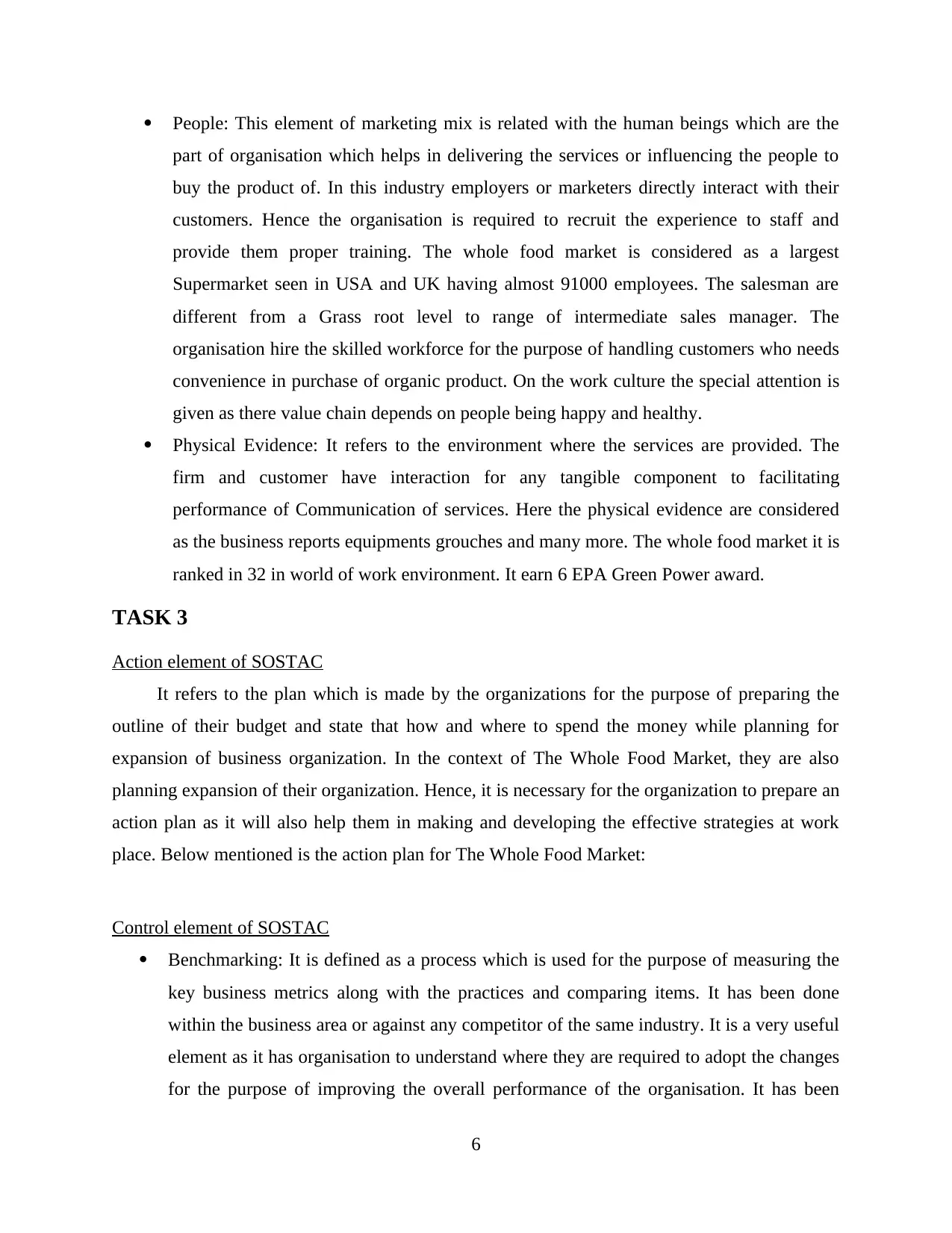
People: This element of marketing mix is related with the human beings which are the
part of organisation which helps in delivering the services or influencing the people to
buy the product of. In this industry employers or marketers directly interact with their
customers. Hence the organisation is required to recruit the experience to staff and
provide them proper training. The whole food market is considered as a largest
Supermarket seen in USA and UK having almost 91000 employees. The salesman are
different from a Grass root level to range of intermediate sales manager. The
organisation hire the skilled workforce for the purpose of handling customers who needs
convenience in purchase of organic product. On the work culture the special attention is
given as there value chain depends on people being happy and healthy.
Physical Evidence: It refers to the environment where the services are provided. The
firm and customer have interaction for any tangible component to facilitating
performance of Communication of services. Here the physical evidence are considered
as the business reports equipments grouches and many more. The whole food market it is
ranked in 32 in world of work environment. It earn 6 EPA Green Power award.
TASK 3
Action element of SOSTAC
It refers to the plan which is made by the organizations for the purpose of preparing the
outline of their budget and state that how and where to spend the money while planning for
expansion of business organization. In the context of The Whole Food Market, they are also
planning expansion of their organization. Hence, it is necessary for the organization to prepare an
action plan as it will also help them in making and developing the effective strategies at work
place. Below mentioned is the action plan for The Whole Food Market:
Control element of SOSTAC
Benchmarking: It is defined as a process which is used for the purpose of measuring the
key business metrics along with the practices and comparing items. It has been done
within the business area or against any competitor of the same industry. It is a very useful
element as it has organisation to understand where they are required to adopt the changes
for the purpose of improving the overall performance of the organisation. It has been
6
part of organisation which helps in delivering the services or influencing the people to
buy the product of. In this industry employers or marketers directly interact with their
customers. Hence the organisation is required to recruit the experience to staff and
provide them proper training. The whole food market is considered as a largest
Supermarket seen in USA and UK having almost 91000 employees. The salesman are
different from a Grass root level to range of intermediate sales manager. The
organisation hire the skilled workforce for the purpose of handling customers who needs
convenience in purchase of organic product. On the work culture the special attention is
given as there value chain depends on people being happy and healthy.
Physical Evidence: It refers to the environment where the services are provided. The
firm and customer have interaction for any tangible component to facilitating
performance of Communication of services. Here the physical evidence are considered
as the business reports equipments grouches and many more. The whole food market it is
ranked in 32 in world of work environment. It earn 6 EPA Green Power award.
TASK 3
Action element of SOSTAC
It refers to the plan which is made by the organizations for the purpose of preparing the
outline of their budget and state that how and where to spend the money while planning for
expansion of business organization. In the context of The Whole Food Market, they are also
planning expansion of their organization. Hence, it is necessary for the organization to prepare an
action plan as it will also help them in making and developing the effective strategies at work
place. Below mentioned is the action plan for The Whole Food Market:
Control element of SOSTAC
Benchmarking: It is defined as a process which is used for the purpose of measuring the
key business metrics along with the practices and comparing items. It has been done
within the business area or against any competitor of the same industry. It is a very useful
element as it has organisation to understand where they are required to adopt the changes
for the purpose of improving the overall performance of the organisation. It has been
6
⊘ This is a preview!⊘
Do you want full access?
Subscribe today to unlock all pages.

Trusted by 1+ million students worldwide
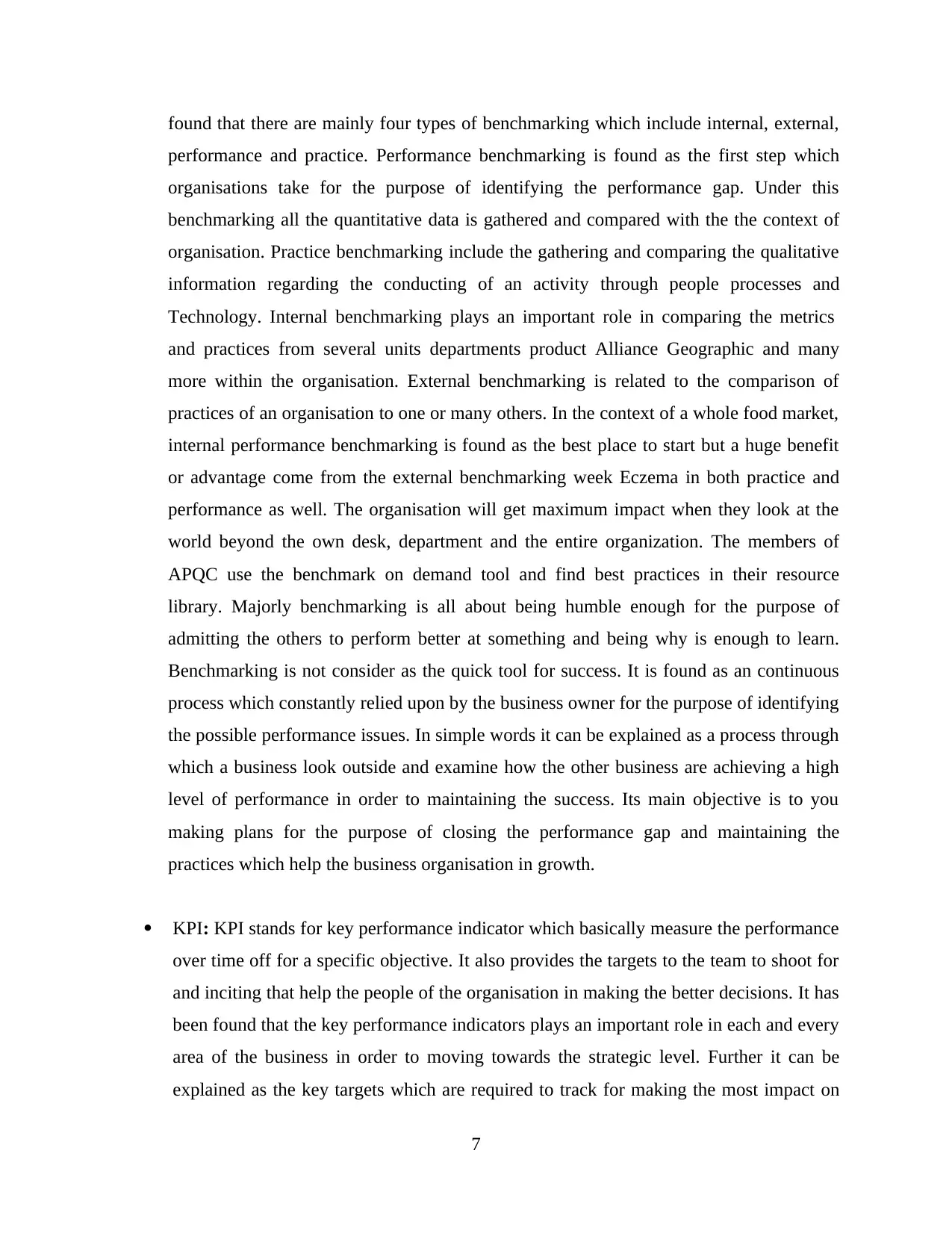
found that there are mainly four types of benchmarking which include internal, external,
performance and practice. Performance benchmarking is found as the first step which
organisations take for the purpose of identifying the performance gap. Under this
benchmarking all the quantitative data is gathered and compared with the the context of
organisation. Practice benchmarking include the gathering and comparing the qualitative
information regarding the conducting of an activity through people processes and
Technology. Internal benchmarking plays an important role in comparing the metrics
and practices from several units departments product Alliance Geographic and many
more within the organisation. External benchmarking is related to the comparison of
practices of an organisation to one or many others. In the context of a whole food market,
internal performance benchmarking is found as the best place to start but a huge benefit
or advantage come from the external benchmarking week Eczema in both practice and
performance as well. The organisation will get maximum impact when they look at the
world beyond the own desk, department and the entire organization. The members of
APQC use the benchmark on demand tool and find best practices in their resource
library. Majorly benchmarking is all about being humble enough for the purpose of
admitting the others to perform better at something and being why is enough to learn.
Benchmarking is not consider as the quick tool for success. It is found as an continuous
process which constantly relied upon by the business owner for the purpose of identifying
the possible performance issues. In simple words it can be explained as a process through
which a business look outside and examine how the other business are achieving a high
level of performance in order to maintaining the success. Its main objective is to you
making plans for the purpose of closing the performance gap and maintaining the
practices which help the business organisation in growth.
KPI: KPI stands for key performance indicator which basically measure the performance
over time off for a specific objective. It also provides the targets to the team to shoot for
and inciting that help the people of the organisation in making the better decisions. It has
been found that the key performance indicators plays an important role in each and every
area of the business in order to moving towards the strategic level. Further it can be
explained as the key targets which are required to track for making the most impact on
7
performance and practice. Performance benchmarking is found as the first step which
organisations take for the purpose of identifying the performance gap. Under this
benchmarking all the quantitative data is gathered and compared with the the context of
organisation. Practice benchmarking include the gathering and comparing the qualitative
information regarding the conducting of an activity through people processes and
Technology. Internal benchmarking plays an important role in comparing the metrics
and practices from several units departments product Alliance Geographic and many
more within the organisation. External benchmarking is related to the comparison of
practices of an organisation to one or many others. In the context of a whole food market,
internal performance benchmarking is found as the best place to start but a huge benefit
or advantage come from the external benchmarking week Eczema in both practice and
performance as well. The organisation will get maximum impact when they look at the
world beyond the own desk, department and the entire organization. The members of
APQC use the benchmark on demand tool and find best practices in their resource
library. Majorly benchmarking is all about being humble enough for the purpose of
admitting the others to perform better at something and being why is enough to learn.
Benchmarking is not consider as the quick tool for success. It is found as an continuous
process which constantly relied upon by the business owner for the purpose of identifying
the possible performance issues. In simple words it can be explained as a process through
which a business look outside and examine how the other business are achieving a high
level of performance in order to maintaining the success. Its main objective is to you
making plans for the purpose of closing the performance gap and maintaining the
practices which help the business organisation in growth.
KPI: KPI stands for key performance indicator which basically measure the performance
over time off for a specific objective. It also provides the targets to the team to shoot for
and inciting that help the people of the organisation in making the better decisions. It has
been found that the key performance indicators plays an important role in each and every
area of the business in order to moving towards the strategic level. Further it can be
explained as the key targets which are required to track for making the most impact on
7
Paraphrase This Document
Need a fresh take? Get an instant paraphrase of this document with our AI Paraphraser
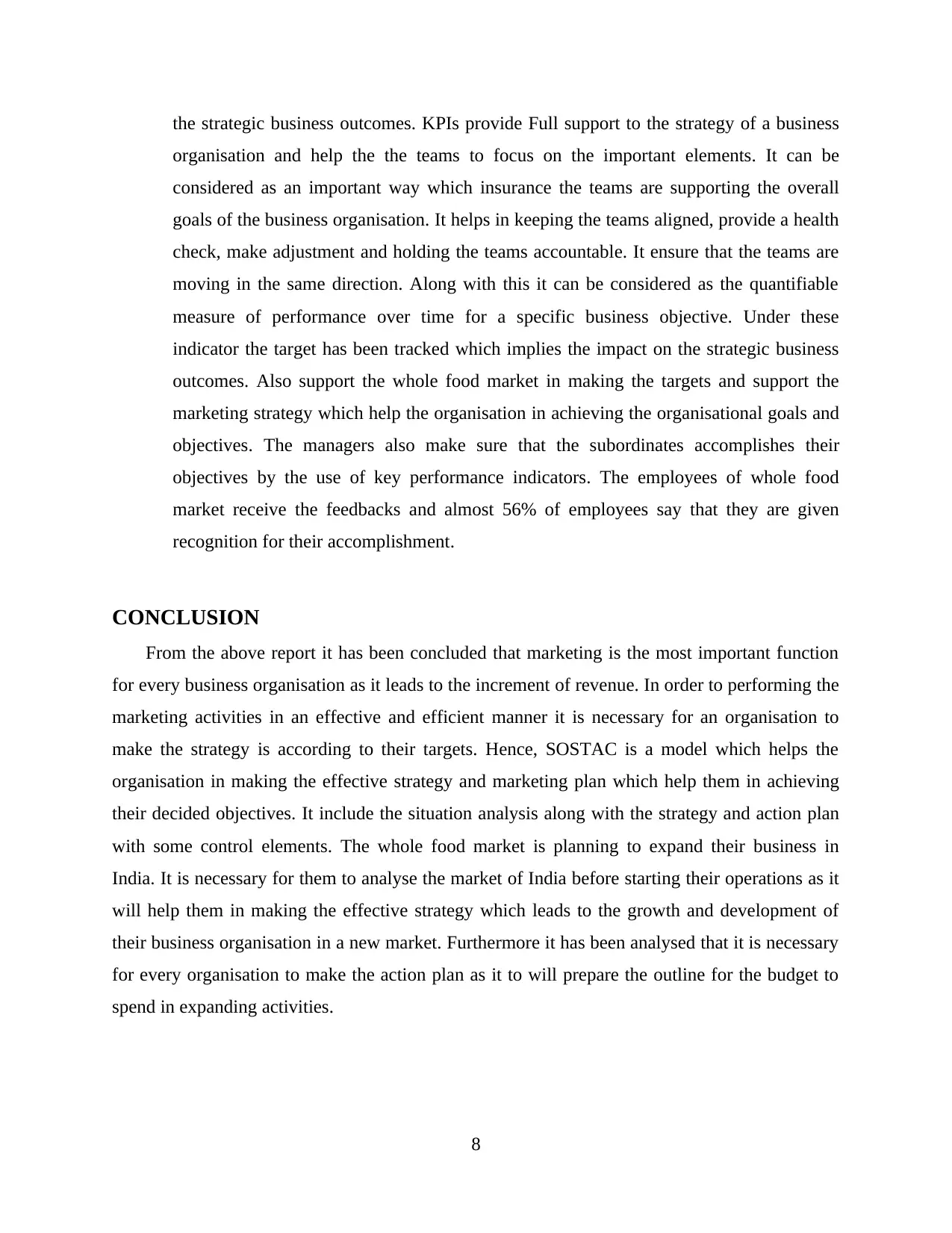
the strategic business outcomes. KPIs provide Full support to the strategy of a business
organisation and help the the teams to focus on the important elements. It can be
considered as an important way which insurance the teams are supporting the overall
goals of the business organisation. It helps in keeping the teams aligned, provide a health
check, make adjustment and holding the teams accountable. It ensure that the teams are
moving in the same direction. Along with this it can be considered as the quantifiable
measure of performance over time for a specific business objective. Under these
indicator the target has been tracked which implies the impact on the strategic business
outcomes. Also support the whole food market in making the targets and support the
marketing strategy which help the organisation in achieving the organisational goals and
objectives. The managers also make sure that the subordinates accomplishes their
objectives by the use of key performance indicators. The employees of whole food
market receive the feedbacks and almost 56% of employees say that they are given
recognition for their accomplishment.
CONCLUSION
From the above report it has been concluded that marketing is the most important function
for every business organisation as it leads to the increment of revenue. In order to performing the
marketing activities in an effective and efficient manner it is necessary for an organisation to
make the strategy is according to their targets. Hence, SOSTAC is a model which helps the
organisation in making the effective strategy and marketing plan which help them in achieving
their decided objectives. It include the situation analysis along with the strategy and action plan
with some control elements. The whole food market is planning to expand their business in
India. It is necessary for them to analyse the market of India before starting their operations as it
will help them in making the effective strategy which leads to the growth and development of
their business organisation in a new market. Furthermore it has been analysed that it is necessary
for every organisation to make the action plan as it to will prepare the outline for the budget to
spend in expanding activities.
8
organisation and help the the teams to focus on the important elements. It can be
considered as an important way which insurance the teams are supporting the overall
goals of the business organisation. It helps in keeping the teams aligned, provide a health
check, make adjustment and holding the teams accountable. It ensure that the teams are
moving in the same direction. Along with this it can be considered as the quantifiable
measure of performance over time for a specific business objective. Under these
indicator the target has been tracked which implies the impact on the strategic business
outcomes. Also support the whole food market in making the targets and support the
marketing strategy which help the organisation in achieving the organisational goals and
objectives. The managers also make sure that the subordinates accomplishes their
objectives by the use of key performance indicators. The employees of whole food
market receive the feedbacks and almost 56% of employees say that they are given
recognition for their accomplishment.
CONCLUSION
From the above report it has been concluded that marketing is the most important function
for every business organisation as it leads to the increment of revenue. In order to performing the
marketing activities in an effective and efficient manner it is necessary for an organisation to
make the strategy is according to their targets. Hence, SOSTAC is a model which helps the
organisation in making the effective strategy and marketing plan which help them in achieving
their decided objectives. It include the situation analysis along with the strategy and action plan
with some control elements. The whole food market is planning to expand their business in
India. It is necessary for them to analyse the market of India before starting their operations as it
will help them in making the effective strategy which leads to the growth and development of
their business organisation in a new market. Furthermore it has been analysed that it is necessary
for every organisation to make the action plan as it to will prepare the outline for the budget to
spend in expanding activities.
8
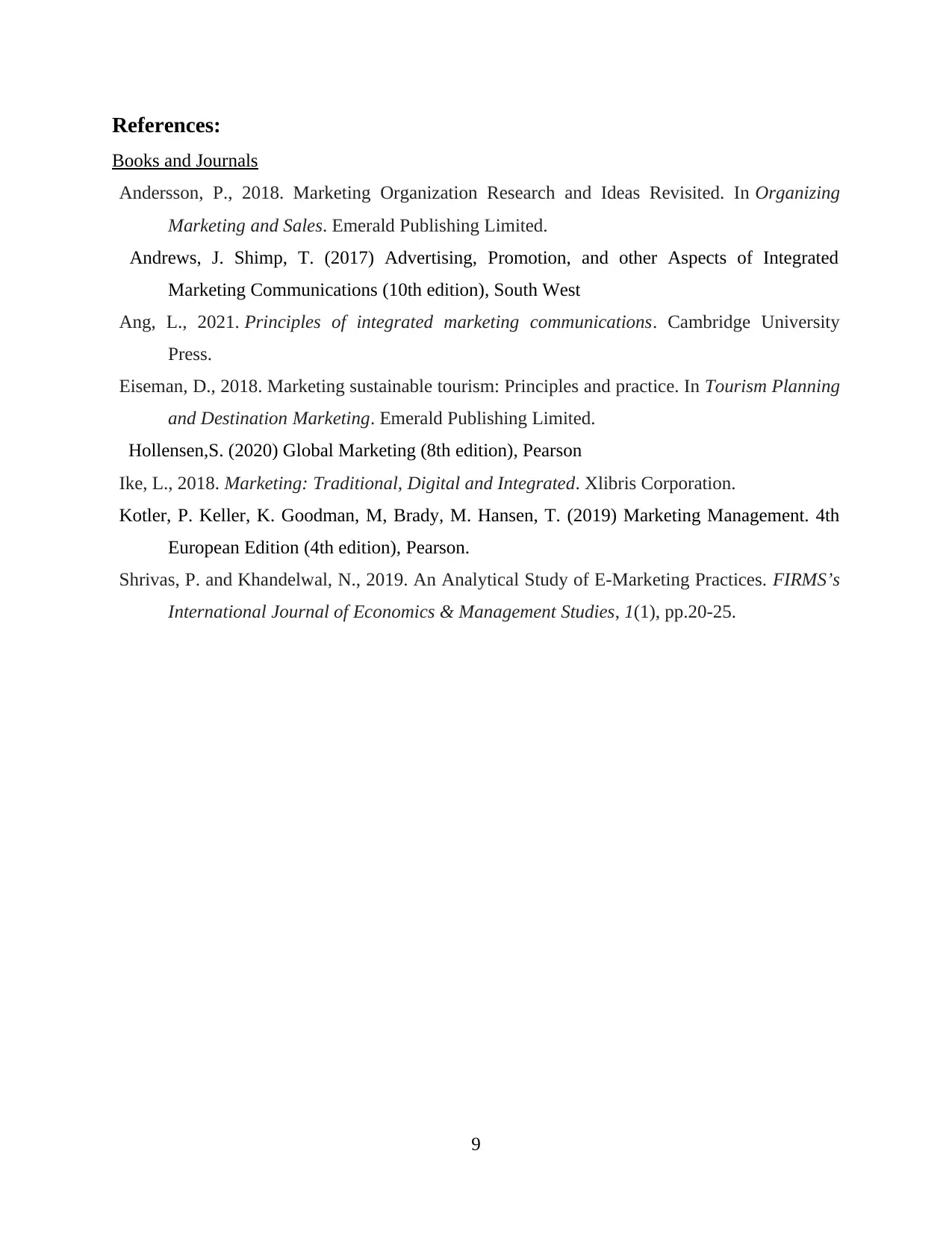
References:
Books and Journals
Andersson, P., 2018. Marketing Organization Research and Ideas Revisited. In Organizing
Marketing and Sales. Emerald Publishing Limited.
Andrews, J. Shimp, T. (2017) Advertising, Promotion, and other Aspects of Integrated
Marketing Communications (10th edition), South West
Ang, L., 2021. Principles of integrated marketing communications. Cambridge University
Press.
Eiseman, D., 2018. Marketing sustainable tourism: Principles and practice. In Tourism Planning
and Destination Marketing. Emerald Publishing Limited.
Hollensen,S. (2020) Global Marketing (8th edition), Pearson
Ike, L., 2018. Marketing: Traditional, Digital and Integrated. Xlibris Corporation.
Kotler, P. Keller, K. Goodman, M, Brady, M. Hansen, T. (2019) Marketing Management. 4th
European Edition (4th edition), Pearson.
Shrivas, P. and Khandelwal, N., 2019. An Analytical Study of E-Marketing Practices. FIRMS’s
International Journal of Economics & Management Studies, 1(1), pp.20-25.
9
Books and Journals
Andersson, P., 2018. Marketing Organization Research and Ideas Revisited. In Organizing
Marketing and Sales. Emerald Publishing Limited.
Andrews, J. Shimp, T. (2017) Advertising, Promotion, and other Aspects of Integrated
Marketing Communications (10th edition), South West
Ang, L., 2021. Principles of integrated marketing communications. Cambridge University
Press.
Eiseman, D., 2018. Marketing sustainable tourism: Principles and practice. In Tourism Planning
and Destination Marketing. Emerald Publishing Limited.
Hollensen,S. (2020) Global Marketing (8th edition), Pearson
Ike, L., 2018. Marketing: Traditional, Digital and Integrated. Xlibris Corporation.
Kotler, P. Keller, K. Goodman, M, Brady, M. Hansen, T. (2019) Marketing Management. 4th
European Edition (4th edition), Pearson.
Shrivas, P. and Khandelwal, N., 2019. An Analytical Study of E-Marketing Practices. FIRMS’s
International Journal of Economics & Management Studies, 1(1), pp.20-25.
9
⊘ This is a preview!⊘
Do you want full access?
Subscribe today to unlock all pages.

Trusted by 1+ million students worldwide
1 out of 12
Related Documents
Your All-in-One AI-Powered Toolkit for Academic Success.
+13062052269
info@desklib.com
Available 24*7 on WhatsApp / Email
![[object Object]](/_next/static/media/star-bottom.7253800d.svg)
Unlock your academic potential
Copyright © 2020–2025 A2Z Services. All Rights Reserved. Developed and managed by ZUCOL.





